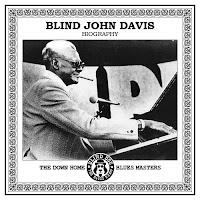For over 50 years, the world-renowned blues pianist had an innate ability to play ragtime, a little jazz, and even a schmaltzy Tin Pan Alley ditty or two.
John Henry Davis, b. December 7, 1913 in Hattiesburg, MS, d. October 12, 1985 in Chicago, IL. Years active 1930s - 1980s.
Davis taught himself piano after being blinded in 1923, and led his own six-piece band for 15 years from 1938. He professed not to care for blues, but his fame rests on the hundreds of blues accompaniments he recorded during the late 30s and early 40s. Among those who used him were 'Big' Bill Broonzy, Tampa Red and Peter J. Clayton. Usually he worked in a small band setting, where his generally unspectacular playing would sometimes show a quiet inventiveness. His self-accompanied 1938 vocal recordings are mediocre, but his back-up work, with its rolling right hand figures, was both immediately recognizable and creatively varied.
In the post-war years, Davis was an early visitor to Europe, recording two albums in Paris in 1952, revealing a personal taste for songs such as 'O Sole Mio' and 'Lady Be Good'. Despite his declared preferences his recorded work emphasized blues and boogie, with a smattering of jazz and popular music. Seldom profound (although his song 'No Mail Today' is a beautiful piece of controlled melancholy), Davis was always proficient and professional.
In 1955 Davis's Chicago house burned down. His wife died in the fire, and his collection of 1700 unique 78-rpm records, some of unissued recordings, was destroyed. Davis died in his adopted hometown of Chicago in October 1985, at the age of 71.
* * *
By Bill Dahl
Versatility was integral to the musical mindset of John Davis. Although he was world-renowned as a blues pianist, he was proud of his innate ability to play ragtime, a little jazz, even a schmaltzy Tin Pan Alley ditty or two. And he did it all for more than half a century. Born in Mississippi, Davis was in reality a Chicagoan, having moved there before the age of three. He lost his eyesight after stepping on a nail when he was nine, but that didn't stop him from learning the 88s as a teen. That way, he could pick up a few bucks by playing in his father's "sporting houses."
Davis held down the enviable position of house pianist for prolific record producer Lester Melrose from 1937 to 1942, rolling the ivories behind the illustrious likes of Sonny Boy Williamson, Tampa Red, and Memphis Minnie for Bluebird, Columbia, Decca, and any other firm the powerful Melrose was connected with. After World War II, the blind pianist assembled his own trio, recording for MGM in 1949-1951. He traveled to Europe with Broonzy in 1952 in what may well have been the first overseas jaunt for any American blues artist.
The pianist remained musically active after that but seldom recorded domestically, saving most of his studio energy for his European tours (a jaunty, typically eclectic 1985 album for Chicago's Red Beans label being a notable exception). Davis' suave, genteel approach didn't jibe with the rough-edged Chicago blues of the '50s, but his sophistication was timeless.


